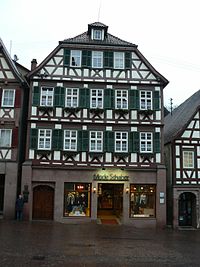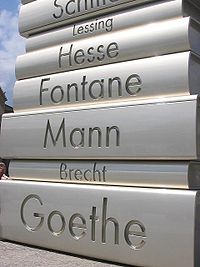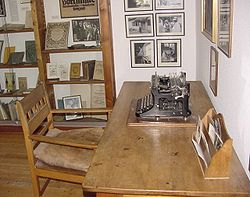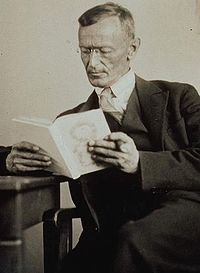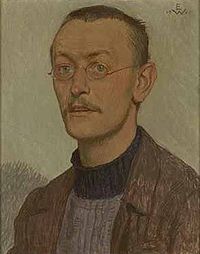- Hermann Hesse
-
Hermann Hesse 
Hermann Hesse in 1927Born 2 July 1877
Calw, Württemberg, GermanyDied 9 August 1962 (aged 85)
Montagnola, SwitzerlandOccupation Novelist, short story author, essayist, poet Nationality German, Swiss Period 1904–1953 Genres Fiction Notable work(s) The Glass Bead Game, Demian, Steppenwolf, Siddhartha Notable award(s) Nobel Prize in Literature
1946
Influences- Plato, Spinoza, Goethe, Schopenhauer, Kierkegaard, Nietzsche, J.P. Jacobsen, Burckhardt, Indian philosophy, Chinese philosophy, Carl Jung[1]
Signature 
Hermann Hesse (German pronunciation: [ˈhɛɐ̯man ˈhɛsə]) (July 2, 1877 – August 9, 1962) was a German-Swiss poet, novelist, and painter. In 1946, he received the Nobel Prize in Literature. His best-known works include Steppenwolf, Siddhartha, and The Glass Bead Game (also known as Magister Ludi), each of which explores an individual's search for authenticity, self-knowledge and spirituality.
Contents
Biography
Family background
Hermann Hesse was born on 2 July 1877 in the Black Forest town of Calw in Württemberg, Germany. Both of Hesse's parents served in India at a mission under the auspices of the Basel Mission, a Protestant Christian missionary society. Hesse's mother, Marie Gundert, was born at such a mission in India in 1842. In describing her own childhood, she said, "A happy child I was not..." As was usual among missionaries at the time, she was left behind in Europe at the age of four when her parents went to India.[2] In her teens she attempted to rebel against her authoritarian father, Hermann Gundert, but finally submitted.[3]
Hesse's father, Johannes Hesse, the son of a doctor, was born in 1847 in the Estonian town of Paide (Weissenstein). In his own way, Dr Hesse was just as tyrannical as Dr Gundert.[4] Once Johannes Hesse was married, he moved into his father-in-law's house. Due at least in part to the crowded conditions there, in 1889 he suffered his first bout of deep depression. He continued to have such attacks of "melancholia, weeping and headaches" for the rest of his life.[5]
Since Johannes Hesse belonged to the sizable German minority in that part of the Baltic region, which was then under the rule of the Russian Empire, his son Hermann was at birth both a citizen of the German Empire and of the Russian Empire.[6] Hesse had five siblings, two of whom died in infancy. In 1873, the Hesse family moved to Calw, where his father worked for the Calwer Verlagsverein, a publishing house specializing in theological texts and schoolbooks. Hesse's grandfather Hermann Gundert managed the publishing house at the time, and Johannes Hesse succeeded him in 1893.
Hesse grew up in a household pervaded with the spirit of Swabian Pietism, with its strong tendency to insulate believers into small, deeply thoughtful groups. Furthermore, Hesse described his father's Baltic German heritage as "an important and potent fact" of his developing identity. His father, Hesse stated, "always seemed like a very polite, very foreign, lonely, little-understood guest."[7] His father's tales from Estonia instilled a contrasting sense of religion in young Hermann. "[It was] an exceedingly cheerful, and, for all its Christianity, a merry world... We wished for nothing so longingly as to be allowed to see this Estonia ... where life was so paradisiacal, so colorful and happy." Hermann Hesse's sense of estrangement from the Swabian petty bourgeoisie further grew through his relationship with his grandmother Julie Gundert, née Dubois, whose French-Swiss heritage kept her from ever quite fitting in among that milieu.[7]
From early on, Hermann Hesse appeared headstrong and hard for his family to handle. In a letter to her husband Johannes Hesse, Hermann's mother Marie wrote: "The little fellow has a life in him, an unbelievable strength, a powerful will, and, for his four years of age, a truly astonishing mind. How can he express all that? It truly gnaws at my life, this internal fighting against his tyrannical temperament, his passionate turbulence [...] God must shape this proud spirit, then it will become something noble and magnificent -- but I shudder to think what this young and passionate person might become should his upbringing be false or weak."[8]
Hesse showed signs of serious depression as early as his first year at school.[9]
In his juvenilia collection Gerbersau, Hesse vividly describes experiences and anecdotes from his childhood and youth in Calw: the atmosphere and adventures by the river, the bridge, the chapel, the houses leaning closely together, hidden nooks and crannies, as well as the inhabitants with their admirable qualities, their oddities, and their idiosyncrasies. The fictional town of Gerbersau is pseudonymous for Calw, imitating the real name of a nearby town called Hirsau. It is derived from the German words gerber, meaning "tanner," and aue, meaning "meadow."[10] Calw had a centuries-old leather-working industry, and during Hesse's childhood the tanneries' influence on the town was still very much in evidence.[11] Hesse's favorite place in Calw was the St. Nicholas-Bridge (Nikolausbrücke), which is why the Hesse monument by the sculptor Kurt Tassotti was erected there in 2002.
Hermann Hesse's grandfather Hermann Gundert, a doctor of philosophy and fluent in multiple languages, encouraged the boy to read widely, giving him access to his library, which was filled with the works of world literature. All this instilled a sense in Hermann Hesse that he was a citizen of the world. His family background became, he noted, "the basis of an isolation and a resistance to any sort of nationalism that so defined my life."[7]
Young Hesse shared a love of music with his mother. Both music and poetry were important in his family. His mother wrote poetry, and his father was known for his use of language in both his sermons and the writing of religious tracts. His first role model for becoming an artist was his half-brother, Theo, who rebelled against the family by entering a music conservatory in 1885.[12] Hesse showed a precocious ability to rhyme, and by 1889-90 had decided that he wanted to be a writer.[13]
Education
In 1881, when Hesse was four, the family moved to Basel, Switzerland, staying for six years and then returning to Calw. After successful attendance at the Latin School in Göppingen, Hesse began to attend the Evangelical Theological Seminary of Maulbronn Abbey in 1891. Here, in March 1892, Hesse showed his rebellious character, and, in one instance, he fled from the Seminary and was found in a field a day later. Hesse began a journey through various institutions and schools and experienced intense conflicts with his parents. In May, after an attempt at suicide, he spent time at an institution in Bad Boll under the care of theologian and minister Christoph Friedrich Blumhardt. Later, he was placed in a mental institution in Stetten im Remstal, and then a boys' institution in Basel. At the end of 1892, he attended the Gymnasium in Cannstatt. In 1893, he passed the One Year Examination, which concluded his schooling. The same year, he began hanging out with older companions and took up drinking and smoking.[14]
After this, Hesse began a bookshop apprenticeship in Esslingen am Neckar, but quit after three days. Then, in the early summer of 1894, he began a 14-month mechanic apprenticeship at a clock tower factory in Calw. The monotony of soldering and filing work made him resolve to turn himself toward more spiritual activities. In October 1895, he was ready to begin wholeheartedly a new apprenticeship with a bookseller in Tübingen. This experience from his youth he returns to later in his novel Beneath the Wheel.
Becoming a writer
On 17 October 1895, Hesse began working in the bookshop in Tübingen, which had a specialized collection in theology, philology, and law.[15] Hesse's tasks consisted of organizing, packing, and archiving the books. After the end of each twelve-hour workday, Hesse pursued his own work further, and he spent his long, idle Sundays with books rather than friends. Hesse studied theological writings and later Goethe, Lessing, Schiller, and several texts on Greek mythology. He also began reading Nietzsche in '95,[16] and that philosopher's ideas of "dual...impulses of passion and order" in humankind was a heavy influence on most of his novels.[17]
By 1898, Hesse had a respectable income that enabled financial independence from his parents. During this time, he concentrated on the works of the German Romantics, including much of the work from Clemens Brentano, Joseph Freiherr von Eichendorff, Friedrich Hölderlin and Novalis. In letters to his parents, he expressed a belief that "the morality of artists is replaced by aesthetics."
During this time, he was introduced to the home of Fraulein von Reutern, a friend of his family. There he met with young people of his own age. His relationships with his contemporaries was "problematic," in that most of them were now at university. This usually left him feeling awkward in social situations.[18]
In 1896, his poem "Madonna" appeared in a Viennese periodical. In the autumn, Hesse released his first small volume of poetry, Romantic Songs. In 1897, a published poem of his, "Grand Valse," drew him a fan letter. It was from Helene Voigt, who the next year married Eugen Diederichs, a young publisher. To please his wife, Diederichs agreed to publish Hesse's collection of prose entitled One Hour After Midnight in 1898 (although it is dated 1899).[19] Both works were a business failure. In two years, only 54 of the 600 printed copies of Romantic Songs were sold, and One Hour After Midnight received only one printing and sold sluggishly. Furthermore, Hesse "suffered a great shock" when his mother disapproved of "Romantic Songs" on the grounds that they were too secular and even "vaguely sinful."[20]
From the autumn of 1899, Hesse worked in a distinguished antique book shop in Basel. Through family contacts, he stayed with the intellectual families of Basel. In this environment with rich stimuli for his pursuits, he further developed spiritually and artistically. At the same time, Basel offered the solitary Hesse many opportunities for withdrawal into a private life of artistic self-exploration, journeys and wanderings. In 1900, Hesse was exempted from compulsory military service due to an eye condition. This, along with nerve disorders and persistent headaches, affected him his entire life.
In 1901, Hesse undertook to fulfill a long-held dream and travelled for the first time to Italy. In the same year, Hesse changed jobs and began working at the antiquarium Wattenwyl in Basel. Hesse had more opportunities to release poems and small literary texts to journals. These publications now provided honorariums. His new bookstore agreed to publish his next work, Posthumous Writings and Poems of Hermann Lauscher.[21] In 1902, his mother died after a long and painful illness. He could not bring himself to attend her funeral, afraid that it would worsen his depression.[22]
Due to the good notices he received for Lauscher, the publisher Samuel Fischer became interested in Hesse[23] and, with the novel Peter Camenzind, which appeared first as a pre-publication in 1903 and then as a regular printing by Fischer in 1904, came a breakthrough: from now on, Hesse could make a living as a writer. The novel became popular throughout Germany.[24] Sigmund Freud "praised Peter Camenzind as one of his favorite readings."[25]
Between Lake Constance and India
With the literary fame, Hesse married Maria Bernoulli (of the famous family of mathematicians[26]) in 1904, settled down with her in Gaienhofen on Lake Constance, and began a family, eventually having three sons. In Gaienhofen, he wrote his second novel, Beneath the Wheel, which was published in 1906. In the following time, he composed primarily short stories and poems. His story "The Wolf," written in 1906-07, was "quite possibly" a foreshadowing of Steppenwolf.[27]
His next novel, Gertrude, published in 1910, revealed a production crisis, he had to struggle through writing it, and he later would describe it as "a miscarriage". Gaienhofen was the place where Hesse's interest in Buddhism was re-sparked. Following a letter to Kapff in 1895 entitled Nirvana, Hesse ceased alluding to Buddhist references in his work. In 1904, however, Arthur Schopenhauer and his philosophical ideas started receiving attention again, and Hesse discovered theosophy. Schopenhauer and theosophy renewed Hesse's interest in India. Although it was many years before the publication of Hesse's Siddhartha (1922), this masterpiece was to be derived from these new influences.
During this time, there also was increased dissonance between him and Maria, and in 1911 Hesse left for a long trip to Sri Lanka and Indonesia. He also visited Sumatra, Borneo, and Burma, but "the physical experience... was to depress him."[28] Any spiritual or religious inspiration that he was looking for eluded him, but the journey made a strong impression on his literary work. Following Hesse's return, the family moved to Bern (1912), but the change of environment could not solve the marriage problems, as he himself confessed in his novel Rosshalde from 1914.
During the First World War
At the outbreak of the First World War in 1914, Hesse registered himself as a volunteer with the Imperial army, saying that he could not sit inactively by a warm fireplace while other young authors were dying on the front. He was however, found unfit for combat duty, but was assigned to service involving the care of war prisoners.[29] In September 1914, Hesse wrote an essay entitled "O Friends, Not These Tones" ("O Freunde, nicht diese Töne"),[a] which was published in the Neue Zürcher Zeitung, on November 3.[30] In this essay he appealed to German intellectuals not to fall for patriotism.[30] He called for subdued voices and a recognition of Europe's common heritage.[31] What followed from this, Hesse later indicated, was a great turning point in his life: For the first time, he found himself in the middle of a serious political conflict, attacked by the German press, the recipient of hate mail, and distanced from old friends. He did receive continued support from his friend Theodor Heuss, and the French writer Romain Rolland, who visited Hesse in August 1915.[32] In 1917, Hesse wrote to Rolland, "The attempt...to apply love to matters political has failed."[33]
This public controversy was not yet resolved when a deeper life crisis befell Hesse with the death of his father on 8 March 1916, the serious sickness of his son Martin, and his wife's schizophrenia. He was forced to leave his military service and begin receiving psychotherapy. This began for Hesse a long preoccupation with psychoanalysis, through which he came to know Carl Jung personally, and was challenged to new creative heights. During a three-week period in September and October 1917, Hesse penned his novel Demian, which would be published following the armistice in 1919 under the pseudonym Emil Sinclair.
Casa Camuzzi
By the time Hesse returned to civilian life in 1919, his marriage had shattered. His wife had a severe episode of psychosis, but, even after her recovery, Hesse saw no possible future with her. Their home in Bern was divided, and Hesse resettled alone in the middle of April in Ticino. He occupied a small farm house near Minusio (close to Locarno), living from 25 April to 11 May in Sorengo. On 11 May, he moved to the town Montagnola and rented four small rooms in a castle-like building, the Casa Camuzzi. Here, he explored his writing projects further; he began to paint, an activity reflected in his next major story, "Klingsor's Last Summer", published in 1920. In 1922, Hesse's novella Siddhartha appeared, which showed the love for Indian culture and Buddhist philosophy that had already developed in his earlier life. In 1924, Hesse married the singer Ruth Wenger, the daughter of the Swiss writer Lisa Wenger and aunt of Meret Oppenheim. This marriage never attained any stability, however.
In 1923, Hesse received Swiss citizenship. His next major works, Kurgast (1925) and The Nuremberg Trip (1927), were autobiographical narratives with ironic undertones and foreshadowed Hesse's following novel, Steppenwolf, which was published in 1927. In the year of his 50th birthday, the first biography of Hesse appeared, written by his friend Hugo Ball. Shortly after his new successful novel, he turned away from the solitude of Steppenwolf and married art historian Ninon Dolbin, née Ausländer. This change to companionship was reflected in the novel Narcissus and Goldmund, appearing in 1930. In 1931, Hesse left the Casa Camuzzi and moved with Ninon to a large house (Casa Hesse) near Montagnola, which was built according to his wishes.
In 1931, Hesse began planning what would become his last major work, The Glass Bead Game (aka Magister Ludi). In 1932, as a preliminary study, he released the novella Journey to the East. The Glass Bead Game was printed in 1943 in Switzerland. He was awarded the Nobel Prize in Literature in 1946.
Later life and death
Hesse observed the rise to power of Nazism in Germany with concern. In 1933, Bertolt Brecht and Thomas Mann made their travels into exile and, in both cases, were aided by Hesse. In this way, Hesse attempted to work against Hitler's suppression of art and literature that protested Nazi ideology. "[H]is third wife ..was Jewish and his opposition to anti-Semitism was expressed publicly long before then."[34] Hesse was criticized for not condemning the Nazi party, but his failure to criticize or support any political idea stemmed from his "politics of detachment [...] At no time did he openly condemn (the Nazis), although his detestation of their politics is beyond question."[35] From the end of the 1930s, German journals stopped publishing Hesse's work, and it was eventually banned by the Nazis.
The Glass Bead Game was Hesse's last novel. During the last twenty years of his life, Hesse wrote many short stories (chiefly recollections of his childhood) and poems (frequently with nature as their theme). Hesse wrote ironic essays about his alienation from writing (for instance, the mock autobiographies: Life Story Briefly Told and Aus den Briefwechseln eines Dichters) and spent much time pursuing his interest in watercolours. Hesse also occupied himself with the steady stream of letters he received as a result of the Nobel Prize, and as a new generation of German readers explored his work. In one essay, Hesse reflected wryly on his lifelong failure to acquire a talent for idleness and speculated that his average daily correspondence was in excess of 150 pages. He died on 9 August 1962 and was buried in the cemetery at San Abbondio in Montagnola, where Hugo Ball is also buried.
Throughout Germany, many schools are named after him. In 1964, the Calwer Hermann-Hesse-Preis was founded, which is awarded every two years, alternately to a German-language literary journal or to the translator of Hesse's work to a foreign language.[36] There is also a Hermann Hesse prize associated with the city of Karlsruhe.[37]
Influence
Following the death of Hesse in 1962, his novels saw a revival in popularity because of their association with some of the popular themes of the 1960s counterculture (or hippie) movement. In particular, the quest-for-enlightenment theme of Siddhartha, Journey to the East, and Narcissus and Goldmund resonated with those espousing counter-cultural ideals. The "magic theatre" sequences in Steppenwolf were interpreted by some as drug-induced psychedelia. These and other Hesse novels were republished in paperback editions and were widely read by university students and young people in the United States and elsewhere.
Hesse's Siddhartha is one of the most popular Western novels set in India. An authorized translation of Siddhartha was published in the Malayalam language in 1990, the language that surrounded Hesse's grandfather, Hermann Gundert, for most of his life. A Hermann Hesse Society of India has also been formed. It aims to bring out authentic translations of Siddhartha in all Indian languages. It has already prepared the Sanskrit translation of Siddhartha.
One enduring monument to Hesse's lasting popularity in the United States is the Magic Theatre in San Francisco. Referring to "The Magic Theatre for Madmen Only" in Steppenwolf (a kind of spiritual and somewhat nightmarish cabaret attended by some of the characters, including Harry Haller), the Magic Theatre was founded in 1967 to perform works by new playwrights. Founded by John Lion, the Magic Theatre has fulfilled that mission for many years, including the world premieres of many plays by Sam Shepard.
Awards
- 1906 - Bauernfeld-Preis
- 1928 - Mejstrik-Preis of the Schiller Foundation in Vienna
- 1936 - Gottfried-Keller-Preis
- 1946 - Goethe Prize
- 1946 - Nobel Prize in Literature
- 1947 - Honorary Doctorate from the University of Bern
- 1950 - Wilhelm-Raabe-Preis
- 1954 - Pour le Mérite
- 1955 - Peace Prize of the German Book Trade
Bibliography
- (1899) Eine Stunde hinter Mitternacht. Novella.
- (1900) Hermann Lauscher
- (1904) Peter Camenzind
- (1906) Unterm Rad (Beneath the Wheel also published as The Prodigy)
- (1908) Freunde. Novella.
- (1910) Gertrud
- (1914) Roßhalde
- (1915) Knulp. (“Three Tales from the Life of Knulp”)
- (1916) Schön ist die Jugend. Novella.
- (1919) Demian (published under the pen name Emil Sinclair)
- (1919) Klein und Wagner
- (1920) Klingsors letzter Sommer (Klingsor's Last Summer)
- (1922) Siddhartha
- (1927) Der Steppenwolf
- (1930) Narziß und Goldmund (Narcissus and Goldmund) (also published as Death and the Lover)
- (1932) Die Morgenlandfahrt (Journey to the East)
- (1943) Das Glasperlenspiel (The Glass Bead Game) (also published as Magister Ludi)
Sources
- Freedman, Ralph, Hermann Hesse: Pilgrim of Crisis: A Biography, Pantheon Books, NY 1978
References
- ^ "Hermann Hesse autobiography". Nobelprize.org. http://nobelprize.org/nobel_prizes/literature/laureates/1946/hesse-autobio.html. Retrieved 2007-07-16.
- ^ Gundert, Adele, "Marie Hesse: Ein Lebensbild in Briefen und Tagebuchern," as quoted in Freedman (1978) pp. 18-19.
- ^ Freedman (1978) p.21
- ^ Freedman (1978) p.23
- ^ iFreedman (1978) p. 38
- ^ Weltbürger – Hermann Hesses übernationales und multikulturelles Denken und Wirken. An exhibition of the Hermann-Hesse-Museum of the City of Calw from 2. July 2009 to 7. February 2010
- ^ a b c Hermann Hesse: Briefe. Frankfurt am Main: Verlag Suhrkamp, 1964. p. 414.
- ^ Volker Michels (ed.): Über Hermann Hesse. Verlag Suhrkamp, Frankfurt am Main, vol 1: 1904–1962, Repräsentative Textsammlung zu Lebzeiten Hesses. 2nd ed., 1979, ISBN 3-518-06831-8, p. 400.
- ^ Freedman, p. 30
- ^ An English equivalent would be "Tannersmead."
- ^ cf. Greiner, Siegfried: Hermann Hesse – Jugend in Calw (1981), p. viii
- ^ Freedman (1978) pp. 30-32
- ^ Freedman(1978) p. 39
- ^ Freedman(1978) p.53
- ^ Heckenhauer
- ^ Freedman(1978) p.69
- ^ Freedman(1978) p. 111
- ^ Freedman(1978) p.64
- ^ Freedman(1978) pp. 78-80
- ^ Freedman(1978), p. 79
- ^ Freedman(1978)p. 97
- ^ Freedman(1978), pp. 99-101
- ^ Freedman(1978) p.107
- ^ Freedman(1978) p.108
- ^ Freedman(1978) p. 117.
- ^ Gustav Emil Müller, Philosophy of Literature, Ayer Publishing, 1976.
- ^ Freedman(1978) p.140
- ^ Freedman(1978) p.149
- ^ "Hermann Hesse Schriftsteller" (in German). Deutsches Historisches Museum. http://www.dhm.de/lemo/html/biografien/HesseHermann/. Retrieved 15 January 2008.
- ^ a b Mileck, Joseph (1977), Hermann Hesse: Biography and Bibliography, Vol.1, Berkley, Los Angeles, London: University of California Press, p. 42, ISBN 0-520-02756-6, http://books.google.com/books?id=zjdi21x9s1oC&pg=PR3&dq=%22Hermann+Hesse:+biography%22#v=onepage&q&f=false, retrieved 11 October 2010
- ^ Freedman(1978) p.166
- ^ Freedman(1978) p.170-71.
- ^ Freedman(1978) p.189
- ^ Galbreath (1974) Robert. "Hermann Hesse and the Politics of Detachment", p63, Political Theory, vol. 2, No 1 (Feb 1974).
- ^ Galbreath (1974) Robert. "Hermann Hesse and the Politics of Detachment", p64, Political Theory, vol. 2, No 1 (Feb 1974)
- ^ Hermann-Hesse-Preis award
- ^ Hermann-Hesse-Preis
External links
- Complete bibliography at Nobelprize.org
- Poems in Dedication to Hermann Hesse, with some of his own incorporated throughout, in English and German, webmastered by S. Wolf Britain, human- and civil-rights advocate
- Works by Hermann Hesse on Open Library at the Internet Archive
- Works by Hermann Hesse at Project Gutenberg
- Hermann Hesse Page - in German and English, maintained by Professor Gunther Gottschalk
- Hermann Hesse in the German National Library catalogue (German)
- Hermann Hesse Portal
- Community of the Journeyer to the East - in German and English
- Concise Biography - originally published by the Germanic American Institute, by Paul A. Schons
- Article at Books and Writers
- The painter Hermann Hesse Galerie Ludorff, Düsseldorf, Germany
- Audio recording in English of Siddhartha from Librivox.org
- Lajos Kovács. "Erziehung in Hermann Hesses "Glasperlenspiel" - Diplomarbeit". GRIN. http://www.grin.com/e-book/53936/erziehung-in-hermann-hesses-glasperlenspiel.
Works by Hermann Hesse Poems Novels Peter Camenzind · Beneath the Wheel · Gertrude · Rosshalde · Knulp · Demian · Klein and Wagner · Klingsor's Last Summer · Siddhartha · Kurgast · Die Nürnberger Reise · Steppenwolf · Narcissus and Goldmund · Journey to the East · Autobiographical Writings · The Glass Bead GameEssay collections Short Stories The Complete Fairy Tales of Hermann Hesse · Stories of Five Decades · Strange News from Another Star
Nobel Laureates in Literature (1926–1950) - Grazia Deledda (1926)
- Henri Bergson (1927)
- Sigrid Undset (1928)
- Thomas Mann (1929)
- Sinclair Lewis (1930)
- Erik Axel Karlfeldt (1931)
- John Galsworthy (1932)
- Ivan Bunin (1933)
- Luigi Pirandello (1934)
- Eugene O'Neill (1936)
- Roger Martin du Gard (1937)
- Pearl S. Buck (1938)
- Frans Eemil Sillanpää (1939)
- Johannes Vilhelm Jensen (1944)
- Gabriela Mistral (1945)
- Hermann Hesse (1946)
- André Gide (1947)
- T. S. Eliot (1948)
- William Faulkner (1949)
- Bertrand Russell (1950)
- Complete list
- (1901–1925)
- (1926–1950)
- (1951–1975)
- (1976–2000)
- (2001–2025)
Categories:- 1877 births
- 1962 deaths
- 19th-century German people
- 20th-century German people
- 19th-century writers
- 20th-century writers
- 19th-century poets
- 20th-century poets
- 19th-century painters
- 20th-century painters
- Nobel laureates in Literature
- German Nobel laureates
- German novelists
- German painters
- German poets
- Swiss-German people
- Swiss novelists
- Swiss painters
- Swiss people of German descent
- Swiss poets
- Mystics
- Baltic-German people
- People of Baltic German descent
- German people of Estonian descent
- Recipients of the Peace Prize of the German Book Trade
- Recipients of the Pour le Mérite (civil class)
- People from the Kingdom of Württemberg
- People from Calw
- Swiss Nobel laureates
Wikimedia Foundation. 2010.

